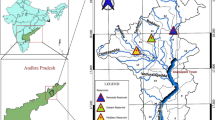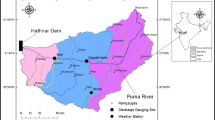Abstract
This article investigates the influence of conceptual flow simulation model parameters (i.e coefficients and constants that need to be estimated in calibration) on model solution (surface runoff) to understand the characteristics of the model. A new conceptual watershed yield model (WYM) was employed. There are four physical parameters, two fitting coefficients and two initial estimates of the surface water and groundwater storagesthat control the functioning of the model. The conceptual model was applied on Ling River near Kahuta and detailed sensitivity analysis was performed to explore the most sensitive model parameters. The most sensitive model parameters worked out were C g (a fitting coefficient, which reflects the rate at whichgroundwater runoff occurs), w r (watershed retention is the initial rainfall losses before runoff begins), p gr (inputparameter that reflects the discharge capacity of the groundwateraquifer). The model parameters like i c (infiltration coefficient), g wsm (input parameter that depends on the subsurface storage available in the watershed) and e p (input parameter) have negligible effect on model solution. It was observed that w r (watershed retention) is the only surface runoff controlling parameter and p gr and C g are the groundwater runoff controlling parameters.
Similar content being viewed by others
References
Blackie, J. R and Eles, C. W. O.: 1985, ‘Lumped Catchment Models’, in M. G. Anderson and T. P. Burt (eds), Hydrological Forecasting, Wiley, New York, U.S.A.
Ciriani, T. A., Maione, U. and Wallis, J. R.: 1977, Mathematical Models for Surface Water Hydrology, Wiley, Chichester, U.K.
Garrick, M., Cunnane, C. and Nash, J. E.: 1978, ‘A Criteria of Efficiency for Rainfall-Runoff Model’, J. Hydrol. 36, 375–381.
Herrero, O. R.: 1974, ‘Estimation of Washload Produced on Certain Small Watershed’, J. Hydraulic Division, ASCE 100(HY7), 835–848.
Ibbitt, R. P. and O'Donnell, T.: 1971, ‘Fitting Methods for Conceptual Catchment Models’, J. Hydraul. Div. ASCE 97(Hy9), 1331–1342.
James, L. D. and Burges, S. J.: 1982, ‘Selection Calibration and Testing of Hydrologic Models, Chapter 11’, in C. T. Haan, H. P. Johnson and D. L. Brakensiek (eds), Hydrologic Modelling of Small Watersheds, ASAE Monograph, No. 5.
Jansen, J. M. L. and Painter, R. B.: 1974, ‘Predicting Sediment Yield from Climate and Topography’, J. Hydrology 21(4), 371–380.
Nabi, A.: 1991, ‘Development and Calibration of a Model for Regional Sediment Yield Estimation’, Dissertation presented to the Centre of Centre of Excellence in Water Resources Engineering, University of Engineering and Technology, Lahore, Pakistan in partial fulfillment of the requirements for the degree of Master of Philosophy in Water Resources Management.
Nash, J. E. and Sutcliff, J. V.: 1970, ‘River Flow Forecasting through Conceptual Models, I – A Discussion of Principles’, J. Hydrology 10, 282–290.
Sorooshian, S. and Gupta, V. K.: 1983, ‘Automatic Calibration of Conceptual Rainfall-Runoff Models: The Question of Parameter Observalibility and Uniqueness’, Water Resour. Res. 19(1), 260–268.
Author information
Authors and Affiliations
Corresponding author
Rights and permissions
About this article
Cite this article
Azhar Khan, A., Saeed Shah, S.M. & Gabriel, H.F. The Influence of Conceptual Flow Simulation Model Parameters on Model Solution. Water Resources Management 16, 51–69 (2002). https://doi.org/10.1023/A:1015575004206
Issue Date:
DOI: https://doi.org/10.1023/A:1015575004206




